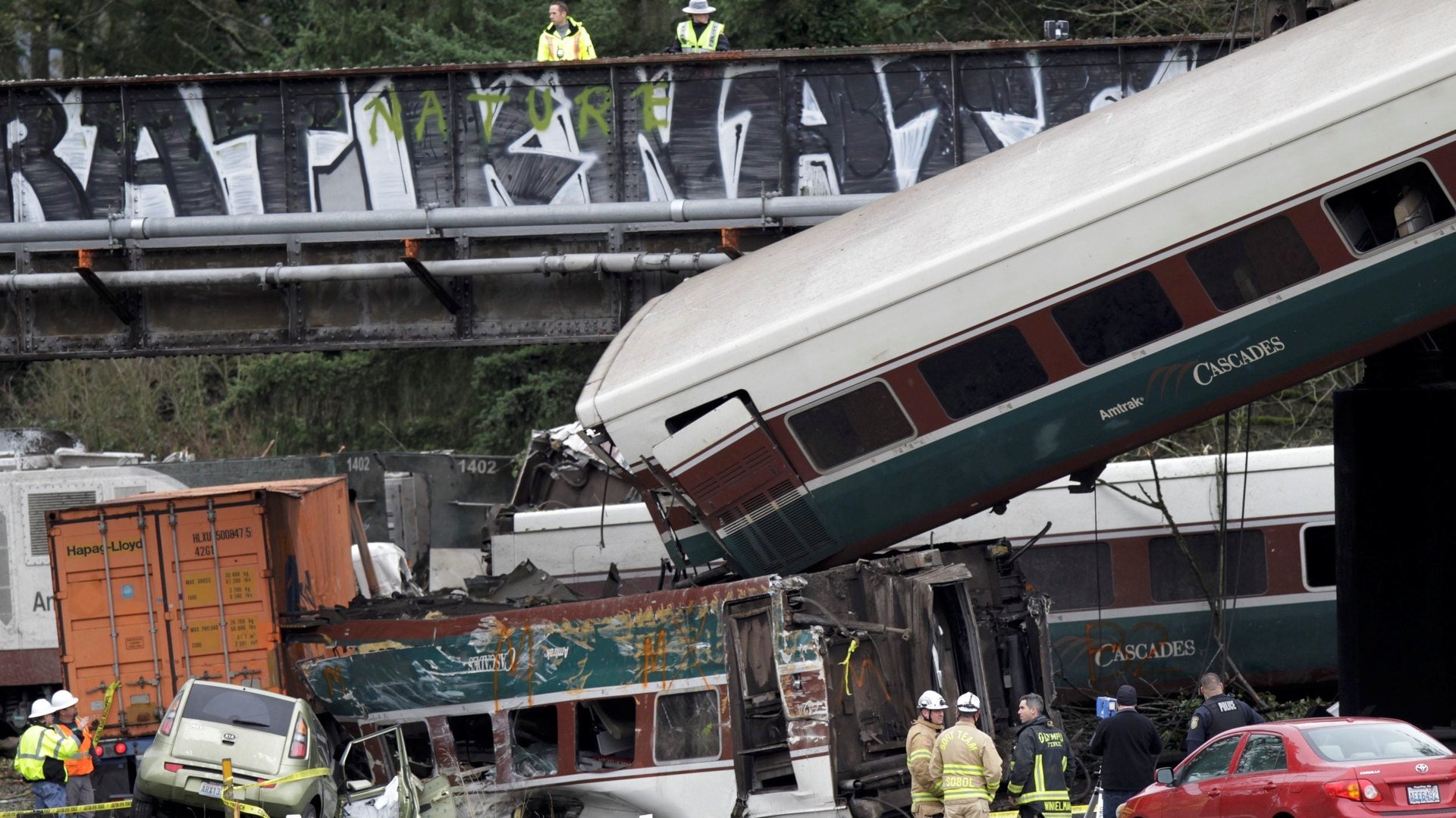What is positive train control and why wasn’t it being used in the Amtrak train crash?
The derailment of Amtrak Cascades train number 501 yesterday, Dec. 18, drew headlines across the US, on account of the three lives lost and stunning visuals of train cars dangling above I-5. Playing out like a cruel twist of fate, the train crashed on its debut run with paying passengers aboard, on a recently-rebuilt stretch of track south of Tacoma, Wash., intended to reduce trip time and boost reliability of trains between Seattle and Portland, Ore. The Itinerant Urbanist blog provides some good context on the incident.


The derailment of Amtrak Cascades train number 501 yesterday, Dec. 18, drew headlines across the US, on account of the three lives lost and stunning visuals of train cars dangling above I-5. Playing out like a cruel twist of fate, the train crashed on its debut run with paying passengers aboard, on a recently-rebuilt stretch of track south of Tacoma, Wash., intended to reduce trip time and boost reliability of trains between Seattle and Portland, Ore. The Itinerant Urbanist blog provides some good context on the incident.
An investigation by the National Transportation Safety Board (NTSB) is underway, but among the factors to be studied will be the role of Positive Train Control (PTC), or more likely, the lack thereof. The Washington State Department of Transportation (WSDOT) noted that PTC equipment is scheduled for installation and activation on the Port Defiance Bypass corridor used by Cascades train #501 in the spring of 2018. It’s possible, although not certain, that active PTC on the route could have prevented Monday’s accident.
PTC is the latest generation of equipment, technology and procedures that can automatically bring a moving train to a rapid halt, dating back to the famed dead-man’s handle of the early 1900s, to automatic train control features introduced in the 1950s by the Pennsylvania Railroad on the Northeast Corridor that Amtrak still uses today to achieve speeds over 110 miles per hour.
PTC integrates modern tools, such as GPS-based location monitoring, cellular, wi-fi and radio networks, and computer coordination that allow railroad equipment like signals, switches and crossing gates to communicate with trains in motion. Among PTC’s many features is its ability to stop a train if it exceeds track speed limits, passes a red signal or gets to close to another train. Amtrak Cascades #501 was traveling at 81 miles per hour when it entered a curve limited to no more than 30 miles per hour.
Additionally, there’s widespread consensus in the rail industry that PTC works successfully when it’s installed. The technology is far less complicated than that used in current autonomous vehicle prototypes and already successfully governs train movements on certain routes in the United States and more extensively overseas. On top of that, the federal government has mandated PTC on rail lines meeting certain conditions, one of which is carrying intercity or commuter passenger trains.
So, what’s the holdup in activating federally-mandated, proven technology that could potentially save lives?
The problem is PTC is both expensive and time-intensive to install. Not only must every locomotive operating on a PTC route have the necessary hardware in place, but equipment also needs to be stationed at key locations along the line. For even a relatively short stretch like the 14.5-mile Port Defiance Bypass, PTC installation costs figure in the millions of dollars. Equipping its entire 500-mile regional rail network with PTC has set Southern California’s Metrolink back more than $200 million.
It was a deadly 2008 head-on crash between a Metrolink train and a Union Pacific freight train in Chatsworth, Calif., that was the impetus for the federal mandate passed by Congress and signed by President George W. Bush in 2008. Congress extended the mandate’s original 2015 deadline until 2018, with options reaching to 2020.
Aside from a few rounds of small-scale federal grants covering but a fraction of PTC installation costs, both passenger and freight railroads are scrambling to raise capital funds to meet PTC deadlines, while muttering “unfunded mandate” back at Washington.
Freight carriers aren’t enamored with paying out of pocket to make passengers safer—as many of their trains travel at speeds below which PTC would make much of a difference. Meanwhile, Amtrak and commuter railroads would rather devote their scarce state and local funds on providing more or better service. Of course, without factoring for insurance, the cost for WSDOT to repair or replace its now-damaged Cascades locomotives and railcars likely outweighs PTC installation expenses on the Port Defiance Bypass route.
Monday’s tragic events underscores not only the urgent need for PTC measures, but the extreme difficulty the rail industry is facing making those technologies a reality.